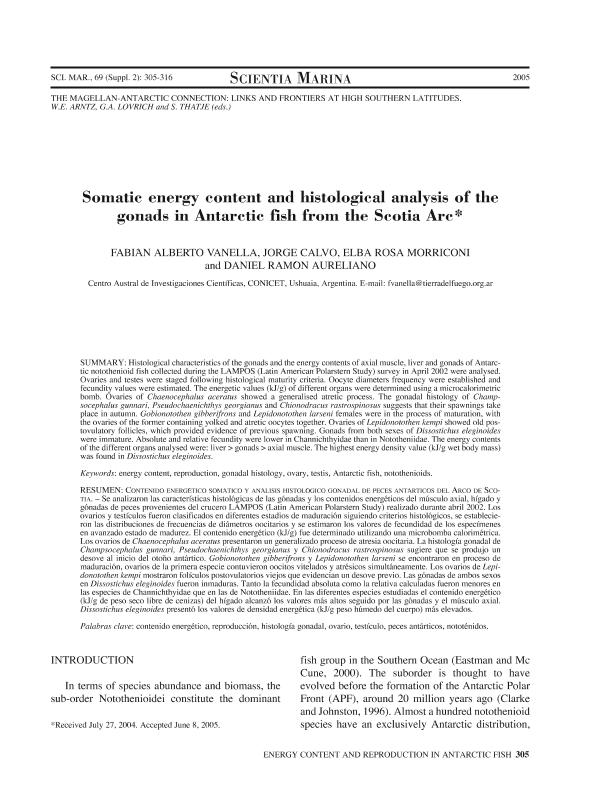Artículo
Somatic energy content and histological analysis of the gonads in Antarctic fish from the Scotia Arc
Fecha de publicación:
06/2005
Editorial:
Instituto de Ciencias del Mar Barcelona
Revista:
Scientia Marina
ISSN:
1618-3193
e-ISSN:
1886-8134
Idioma:
Inglés
Tipo de recurso:
Artículo publicado
Clasificación temática:
Resumen
Low temperatures and highly seasonal productivity, both characteristics of the Antarctic marine environment, influence the energy budget of Antarctic fish and their reproductive timing. This study analyses the histological characteristics of gonads and the energy contents of muscle, liver and gonads of several species of Notothenioids. Previous studies on this subject are scarce and most reproductive studies have been limited to macroscopic descriptions of gonads. The fish used in this research were collected during the LAMPOS survey in April 2001. Testes and ovaries were staged following histological maturity criteria and oocyte frequency diameters and fecundity values were estimated. The calorific value (kJ/g) of the axial muscle, liver and gonads were determined using a microcalorimetric bomb. The gonads from both sexes of Dissosticus eleginoides and Pseudochaenichthys georgianus were immature as the specimens collected had not reached first maturation size. Ovaries obtained from Chaenocephalus aceratus and Gobionotothen giberifrons showed yolked oocytes (secondary advanced vitellogenesis) and most of the specimens had a considerable amount of atretic oocytes. The testes of the latter species showed a large amount of spermatocyte cysts. Lepidonotothen larseni ovaries were found to be in secondary advanced vitellogenesis. Champsocephalus gunnari ovaries contained totally mature oocytes while the testes were practically all completely mature. Smaller specimens of Lepidonotothen kempi had gonads in an advanced state of maturation, while the larger specimens showed histological characteristics typical of postspawning. Fresh postovulatory follicles, corresponding to recent spawning, were present in Chionodracus rastrospinosus, a mature female of this species was also found. Nototeniidae fecundity is notoriously superior to that of Channichthyidae. In the different species the liver energy content (kJ/g) reached the highest levels, followed by the gonads and axial muscle. Energy content values for axial muscle of the different species were the same except for Dissosticus eleginoides which reached values 20% above average. Chionodracus rastrospinosus and Pseudochaenichthys georgianus livers showed the highest values of energy content. Gobionotothen giberifrons liver energy content values were significantly higher in specimens from the northern stations as compared to those from southern stations. Few comparative studies have analysed Southern Ocean fish species for calorific content and none have compared the values obtained from different organs in each species. The variability expressed in these results indicates the need to continue these studies including a larger amount of specimens and species.
Palabras clave:
.CONTENIDO ENERGETICO
,
REPRODUCCIÒN
,
TESTICULO
,
OVARIO
Archivos asociados
Licencia
Identificadores
Colecciones
Articulos(CADIC)
Articulos de CENTRO AUSTRAL DE INVESTIGACIONES CIENTIFICAS
Articulos de CENTRO AUSTRAL DE INVESTIGACIONES CIENTIFICAS
Citación
Vanella, Fabián Alberto; Calvo, Jorge; Morriconi, Elba Rosa; Aureliano, Daniel; Somatic energy content and histological analysis of the gonads in Antarctic fish from the Scotia Arc; Instituto de Ciencias del Mar Barcelona; Scientia Marina; 69; S2; 6-2005; 305-316
Compartir
Altmétricas




